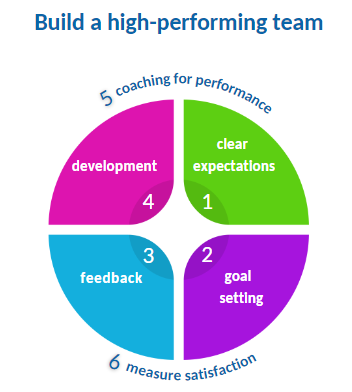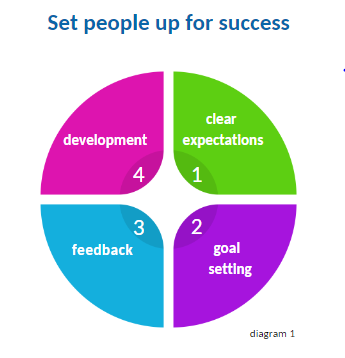Driving high performance in SME's
In a small team, performance really matters because one poor performer can make a big difference. Most SME’s (Small or Medium-Sized Enterprises) don’t have an HR department to roll out best-practice HR and resolve people problems - so, how can busy entrepreneurs drive high performance?
Are you frustrated by the amount of time you spend dealing with people issues. Do you dream of a workforce of capable, motivated people who you can rely on to get results? Read on to find out more.
In this article, I break down the drivers of performance into two parts:
A: Set people up for success (get the basics right so that people deliver results)
B: Build a high-performing team (make your people a competitive advantage)
A. Set people up for success
There are four key steps in setting people up to successfully deliver the results you want – see diagram 1 below:
1. Clear expectations
Assuming that you’ve hired the right person for the job, the first step is to paint a clear picture of what “good performance” looks like with a detailed job description. Here are my recommendations for writing an effective job description that communicates exactly what you expect your team member to achieve:
- Use plain language (see my blog: Plain language gets results). If you write in a style that’s easily accessible to most people, it’s more likely that you and your team will be on the same page about your expectations. Research shows that regardless of reading ability, people prefer plain language for routine business communication.
- State the overall purpose of the role. How does it contribute to achieving your business goals?
- When describing the duties, focus on outputs rather than tasks. This keeps the emphasis on what the person needs to deliver and helps them to prioritize.
- Include descriptions of the most important competencies or “soft skills” for success in the role.
Once everyone is on the same page about what good performance looks like, set goals with your team member to move the focus to specific, measurable targets and deadlines.
2. Goal Setting
Here are my recommendations for implementing goals in a way that supports people to consistently take action to achieve them:
- Provide context by linking individual goals to the overall vision and strategy of the business. This creates a sense of common purpose because people understand how their achievements contribute to the company’s success
- Work with your people to set realistic but challenging goals. Providing the right level of challenge is key in creating motivation.
- Help people to create a plan to achieve their goals. Get them thinking about how they will achieve each goal and break it down into key steps, activity levels, milestones, and timeframes.
- Measure the actual results that people achieve and report on progress. A simple, transparent goal-tracking and reporting system helps to provide clarity.
- Check in on your team members regularly to monitor their progress. Support them to trouble-shoot and overcome obstacles to achieve their goals.
Once you’ve clarified expectations and set goals, the next step is to provide feedback on how people are actually doing.
3. Feedback
Feedback is a tool for getting more of what you want from people by recognising and rewarding success and taking timely action to resolve problems. Effective feedback includes both on-the-job (real-time) and more formal (performance appraisal) feedback. Here are my tips for providing effective feeback to your people:
- Make it a habit to “catch people doing something right”. According to research by Ezra Coaching, the magic ratio for improving performance is five pieces of positive reinforcement for every piece of constructive criticism. (People perform best when they feel successful).
- Link feedback to the expectations and goals for the role, with specific, objective examples.
- People can be defensive about constructive criticism, so aim to strike a balance between being direct (to eliminate misunderstandings) but empathetic (so that the person is willing to change).
- When it comes to a formal performance appraisal, make sure your evaluation is consistent with on-the-job feedback people have received. Aim to remove any personal bias (or perception of bias) by getting feedback from other sources (managers, colleagues, customers).
- Make the most of performance appraisals to motivate your team by getting them focussed on ongoing development and future opportunities.
This leads us to the next step in building a high-performing team - a focus on ongoing development.
4. Development
Research shows that investment in learning and development is one of the top 10 features of high-performing organisations. Learning and development opportunities improve engagement, staff retention and productivity. So how do you make sure that your investment in staff development provides a good return on investment? Here are my tips:
- Link development to business strategic goals and career goals for team members. What skills and knowledge will people need to achieve long-term goals?
- Select the right activity to get the result you want and to fit the learning style of the individual. (For example: mentoring, coaching, external training, internal training, on-the-job training and virtual training).
- Assess the impact of development activities to build a database of training that delivers results for your organisation.
- Consider a strengths-based approach to development. Gallup research shows that high-performing organisations focus on maximising the natural strengths and talents of their people, rather than trying to “fix” their weaknesses.
In a small business, it can be challenging to carve out time for training but ongoing development of your team could provide a competitive edge.
If you master steps 1-4 above, you’ll create a workplace where people know exactly what their job is and where they feel supported in striving to achieve targets.
B. Build a high-performing team
If you want to take your team’s performance to the next level, keep reading to find out more about how coaching for performance and measuring satisfaction can impact results (steps 5 and 6 in the diagram below).

5. Coaching for performance
Coaching for performance is a very effective development tool for building high performing teams. Research shows that it improves resilience and the ability to achieve goals autonomously.
In his book “Coaching for Performance” John Whitmore explains the psychology behind coaching:
- A coach is a facilitator and sounding board who creates a relationship of trust and support so that open and honest conversations about performance can happen.
- Coaching brings out the potential in people by building awareness, responsibility and self-belief.
- People take responsibility when they have a choice. “When I want to, I perform better than when I have to.”
- Even if an end goal is non-negotiable, people can be coached for ownership by offering choices in how to reach the goal.
The attributes and competencies of an effective coach are:
- Optimism about the potential of the coachee.
- Active listening skills and sensitivity to non-verbal communication.
- Powerful questioning ability to create awareness of performance blocks and guide the coachee through a process of setting and achieving goals.
- Sound judgement about when to use different coaching techniques (for example building self-esteem, asking probing questions, setting challenges.…).
A coaching approach to developing people may not come naturally to all managers, but offering your people access to coaching could be a great investment to build a high-performing team.
Up to this point, this article has focussed on how to manage/coach people for performance. The final step (measuring satisfaction) allows your team to give you feedback on their experience as an employee and supports the continuous improvement of people management processes.
6. Measure satisfaction
Regular surveys of employee satisfaction provide useful data to maintain an environment where people feel happy and motivated in their work. The feedback you get from your team will let you know what’s working well and will identify any sources of dissatisfaction (including problems that you may not be aware of). To get the best results:
- Set yourself up for success by being ready to action any areas for improvement.
- Collect feedback anonymously to encourage open and honest communication.
- Communicate the results, highlighting the great things about your business and identifying any areas for improvement.
- Involve your team members in implementing solutions. Create an action plan, prioritizing changes that will have the most impact on employee satisfaction.
- Continue to measure satisfaction on a regular basis to track progress.
Having reviewed the strategies in this article for building high-performing teams, how do you think your business is doing? Do you need to work on the basics or are you ready to really drive high performance?
The payoff of a high-performing team
Imagine if all your team members were consistently producing great business results in a happy, supportive working environment. How would this affect your bottom line and your experience as an employer? It’s certainly worth the effort to put structure around people management to drive high performance. If this process seems daunting or you simply don’t have the time to do it, please reach out. I’m passionate about implementing best practice people management that works for SME’s.
Posted: Thursday 9 February 2023
Recent Posts
Archive



